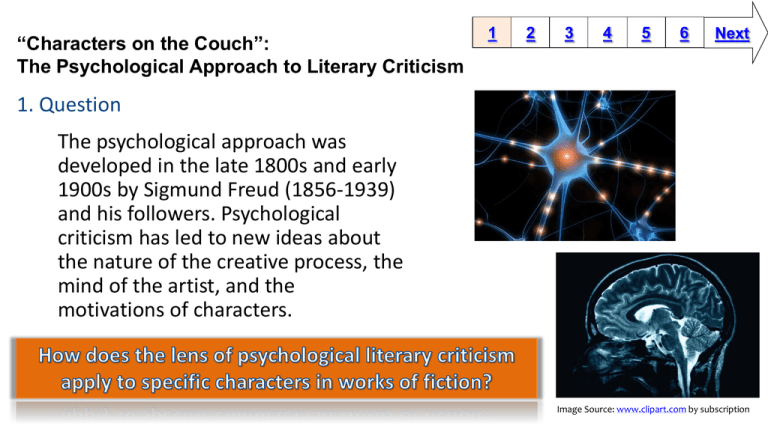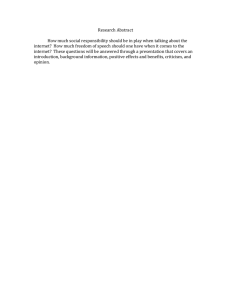
“Characters on the Couch”:
The Psychological Approach to Literary Criticism
1
2
3
4
5
6
Next
1. Question
The psychological approach was
developed in the late 1800s and early
1900s by Sigmund Freud (1856-1939)
and his followers. Psychological
criticism has led to new ideas about
the nature of the creative process, the
mind of the artist, and the
motivations of characters.
Image Source: www.clipart.com by subscription
2. Information Sources
1
2
3
Psychological Analysis can look closely at the characters
and the psychological motivations present in their story
and/or back story.
Psychological Analysis can also look closely at the life of
the author to determine what in his/her life caused
him/her to write characters in a specific way and give the
characters specific attributes.
4
5
6
Next
Image Source:
SIRS, by
subscription
Digital Resources on the Psychological Approach :
Sigmund Freud
Abraham Maslow
Alfred Adler | Adlerian Concepts
Carl Jung
Lawrence Kohlberg
Erik Erikson | Erikson’s Ego Psychology
Freud
Image Source: World Book
Advanced, by subscription
Jung
3. Student Activity
1
2
3
4
Use this Inquiry Organizer to gather
information on each theorist and answer
the questions provided. You will use the
resources found on slide 2 to complete
the worksheet.
Focus on what each theorist proposes as a
motivation for human behavior.
Provide the name of the information
source you used to answer each question
Image Source: www.clipart.com by subscription
5
6
Next
1
4. Assessment Activity
2
3
4
5
6
Now you will apply concepts from the psychological approach to characters in works of fiction.
Your teacher will approve your character choice before you begin to create your product. Options for
your product include but are not limited to…
• Writing a journal entry (paragraph) explaining how your characters actions/motivations
can be examined through the lens of the psychological approach.
•Your teacher may have you share your journal entry by posting it on a Wiki page, Padlet or Voice
Thread (text or audio entry).
•One pager to create a collage using text from your notes, digital images and text from your
assigned text. The scoring tool is included.
•Glogster to create a Glog (interactive poster) using text from your notes and digital images
from the information sources. Scoring Tool for student created Glogsters.
•Your teacher or library media specialist can provide instructions for accessing student accounts in
Glogster and sharing your Glog with classmates.
Examples of a student made Glog that discusses character analysis/ literary criticism
In the Time of Butterflies
Next
5. Enrichment Activities
1
2
3
4
5
6
Next
Here are some online resources to help assist you in applying
literary criticism……
Browse for Criticism
Critical Lens
Here are videos on the theories behind the psychological
approach to further your understanding
Abraham Maslow’s Hierarchy of Needs
Kohlberg Moral Development
Click the image above to play a video about
Freud’s theories regarding the Id, Ego & Superego
6. Teacher Support Materials
Grade 10 English Language Arts
Common Core State Standards
Reading: 1. Read closely to determine what the text says explicitly and to make logical inferences from it; cite specific
textual evidence when writing or speaking to support conclusions drawn from the text.
Writing: 7. Conduct short as well as more sustained research projects based on focused questions, demonstrating
understanding of the subject under investigation.
RL.11.5 (Reading Literature Grade 11 standard 5) Analyze how an author’s choices concerning how to structure
specific parts of a text contribute to its overall structure and meaning as well as its aesthetic impact.
W.11.2 (Writing Grade 11 standard 2) Write informative/explanatory texts to examine and convey complex ideas,
concepts, and information clearly and accurately through the effective selection, organization and analysis of
content.
SL.11.4 (Speaking and Listening Grade 11 Standard 4) Present information, findings and clear supporting evidence,
conveying a clear and distinctive perspective such that listeners can follow the line of reasoning, alternative or
opposing perspectives are addressed and the organization, developments, substance, and style are appropriate
to purpose audience and range of formal and informal tasks.
Standards for the 21st Century Learner
1.1.6 Read, view, and listen for information presented in any format (e.g. textual, visual, media,
digital) in order to make inferences and gather meaning.
2.1.3 Use strategies to draw conclusions from information and apply knowledge to curricular areas,
real-world situations, and further investigations.
1
2
3
4
5
6
Time Frame:
Two 45 minute class periods for research in the library
lab. One period in class or lab for assessment.
Differentiation:
•
Direct students to use comprehension tools
included in databases, such as: audio read-aloud,
labeled reading levels, and embedded
dictionaries.
Learning Styles:
Visual, Auditory, Active, Reflective, Global
Understanding, Analytical Understanding
AVID Strategies:
One Pager
Notes to the teacher:
Teachers should choose/ approve what character
students will examine for the assessment piece of this
lesson.
Teachers will need to see their technology liaison or
library media specialist for assistance in creating
accounts for Wall Wisher, Voice Thread and Glogster.
Last updated: July 2014
Created by Sarah McComb linked to email address, Social Studies teacher, Updated by Heather Jennings, STAT teacher
BCPS Slam Dunk Research Model, Copyright 2014, Baltimore County Public Schools, MD, all rights reserved. The models may be used for educational, non-profit school use only.
All other uses, transmissions, and duplications are prohibited unless permission is granted expressly. This lesson is based on Jamie McKenzie’s Slam Dunk Lesson module.



